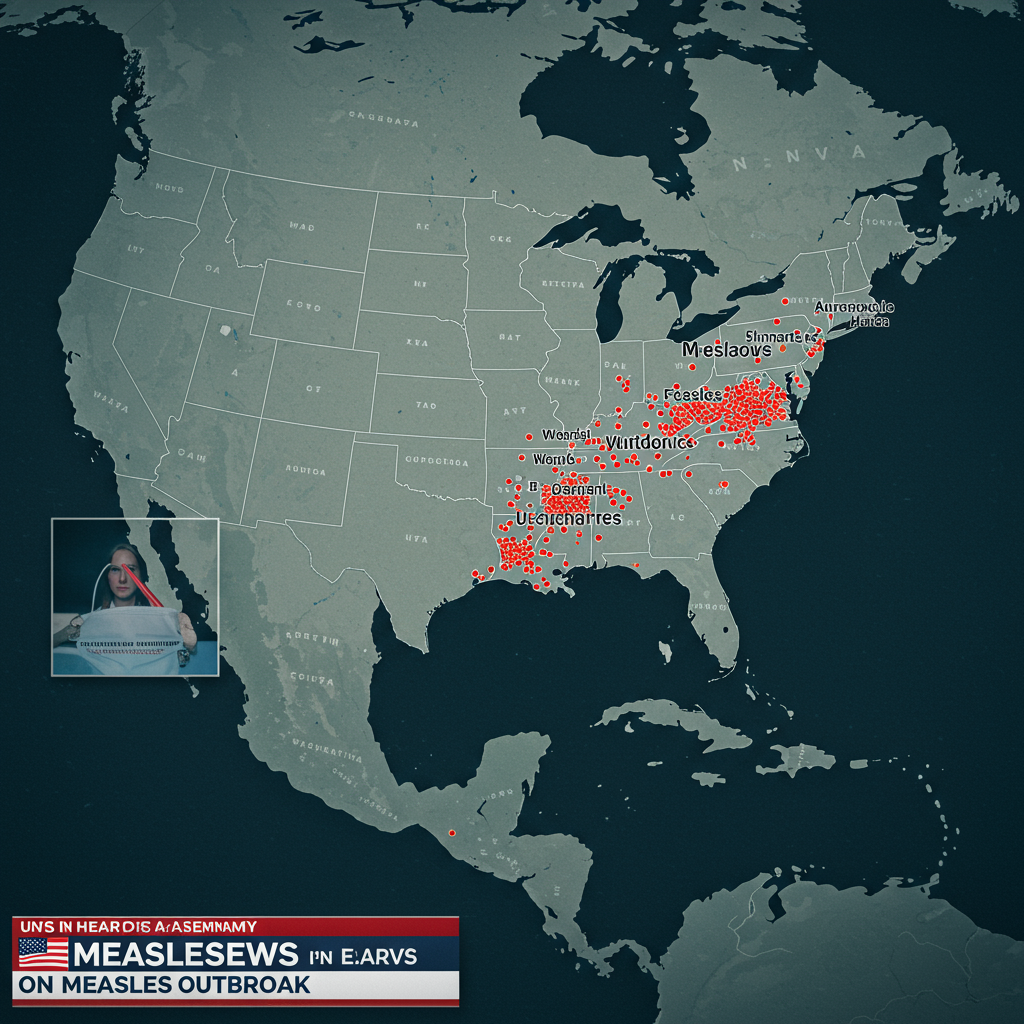Concerns are mounting as the number of confirmed measles cases across the United States has surpassed 1,200 for the year. This milestone was reached as Iowa announced its first outbreak, joining a growing list of states grappling with the highly contagious, yet preventable, disease.
As of Friday, June 20, 2025, the Centers for Disease Control and Prevention (CDC) reported a national total of 1,214 confirmed measles cases. While the past week saw fewer than 20 new cases nationwide, new outbreaks continue to emerge, highlighting the ongoing challenge posed by the virus. Iowa confirmed its first outbreak on Thursday, just a day after Georgia announced its second.
This year’s case count is approaching the 1,274 cases reported in 2019, a year when the U.S. nearly lost its status of having eliminated measles. The re-emergence and spread of measles underscore the vulnerability of communities with low vaccination rates.
A Look at Major Measles Hotspots
Active measles outbreaks, defined by the CDC as three or more related cases, are currently ongoing in multiple states. The scale and location of these outbreaks vary significantly:
Texas: Remains the state with the largest outbreak, which began in late winter and spring. As of earlier this week, Texas reported 750 cases across 35 counties, primarily in West Texas. This widespread activity has led to 97 hospitalizations. Over half of Texas’s cases (55%) are concentrated in Gaines County, where the virus spread rapidly within a close-knit, undervaccinated community.
Kansas: Has recorded a significant outbreak with 79 cases across 11 southwestern counties. Most cases are linked, with the majority occurring in Gray County, resulting in three hospitalizations.
New Mexico: Has seen 81 cases, mostly concentrated in Lea County. Seven people have required hospitalization in the state.
North Dakota: Which hadn’t seen measles since 2011, has reached 34 cases. All confirmed cases were in unvaccinated individuals, and two have been hospitalized. Cases are spread across multiple counties bordering Montana and Canada.
Montana: Reported its first measles cases in 35 years this year, now totaling 22 cases. The initial cluster was in Gallatin County, but cases have also been reported in Flathead, Yellowstone, and Hill counties, near neighboring outbreaks in North Dakota and Canada.
Other States with Active Outbreaks: In addition to the above, Arizona, Colorado, Illinois, Georgia, and Iowa are also reporting active outbreaks. These include clusters linked to international travel, exposure at airports, and household spread. For example, Colorado’s cases include an outbreak linked to an international flight, while Iowa’s recent outbreak involves a household cluster in eastern Johnson County.
Measles cases have also been confirmed this year in many other states, including Alaska, Arkansas, California, District of Columbia, Florida, Hawaii, Indiana, Kentucky, Louisiana, Maryland, Michigan, Minnesota, Missouri, Nebraska, New Jersey, New York, Rhode Island, South Dakota, Vermont, Virginia, and Washington. Previously active outbreaks in Indiana, Michigan, Ohio, and Pennsylvania have been declared over.
Measles Deaths Reported in the US
Tragically, the resurgence of measles has led to deaths in the United States this year. Two elementary school-aged children in West Texas and an unvaccinated adult in New Mexico have died from measles or related complications. All three individuals were unvaccinated. These deaths serve as a stark reminder of the potential severity of measles, particularly for those without immunity.
North American Context: Outbreaks Beyond the US
The situation in the U.S. is part of a larger picture of significant measles activity across North America.
Canada: Is experiencing major outbreaks, including a prolonged situation in Ontario with over 2,100 cases reported since mid-October, tragically including one death in a baby. Alberta has also recorded nearly 1,000 cases this year.
Mexico: The state of Chihuahua has reported a large outbreak with over 2,300 cases and four deaths.
These neighboring outbreaks highlight how easily measles can spread across borders, often introduced into communities by unvaccinated travelers.
Understanding Measles: Highly Contagious and Dangerous
Measles is caused by a highly contagious virus that spreads through the air when an infected person breathes, coughs, or sneezes. It is so contagious that up to 9 out of 10 unvaccinated people exposed to someone with measles will contract the disease.
Symptoms typically begin with a high fever, runny nose, cough, and red, watery eyes. A characteristic rash appears three to five days later, starting on the face and spreading down the body. While many people recover, measles can lead to serious complications such as pneumonia (infection of the lungs), encephalitis (brain swelling), blindness, and death, especially in young children, pregnant women, and immunocompromised individuals. There is no specific treatment for measles; medical care focuses on managing symptoms and preventing complications.
The Importance of the MMR Vaccine
The most effective protection against measles is the Measles, Mumps, and Rubella (MMR) vaccine. The CDC recommends two doses: the first for children between 12 and 15 months old, and the second between 4 and 6 years old. For adults unsure of their immunity, getting an MMR shot is safe and recommended.
Vaccination is crucial not only for individual protection but also for achieving herd immunity, which helps prevent outbreaks by making it difficult for the virus to spread within a community. Experts emphasize that vaccination rates above 95% are needed for robust herd immunity against measles.
Alarmingly, childhood vaccination rates nationwide have declined since the pandemic, and more parents are seeking non-medical exemptions, creating pockets of vulnerability. This erosion of herd immunity makes communities susceptible to outbreaks when the virus is introduced, often by unvaccinated individuals returning from areas with high measles activity abroad.
The current surge in U.S. measles cases, including new outbreaks like the one in Iowa, serves as a critical reminder of the importance of ensuring everyone eligible is vaccinated to protect against this serious, preventable disease.



